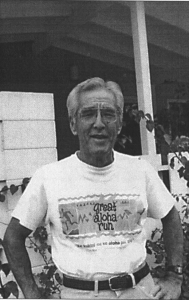Masuo Kino

Tsunamis Remembered: Oral Histories of Survivors and Observers in Hawai‘i
Life history interviews with individuals who witnessed and survived tsunamis-particularly the 1946 and 1960 disasters on the Big Island of Hawai'i. Thirty individuals-mostly residents of Hilo and Laupahoehoe-recall their experiences before; during, and after the 1946 and 1960 tsunamis which were arguably the most destructive natural disasters in modem Hawaiian history.
Masuo Kino was born April 2, 1929 in Kahuku Mauka (near N"mole), Hawai'i. His father, Kenkin Kino, was a laborer and independent sugarcane grower for Hakalau Plantation Company. His mother, Makato Inamine Kino, was a housewife who raised five children of which Masuo was the youngest. Kenkin and Makato Kino were immigrants from Okinawa. Masuo helped his father and mother in the sugarcane fields. Living in a very rural area, the family survived with no electricity and plumbing and relied on poultry and livestock for food and other necessities. Kino attended John M Ross School until grade eight, when he began attending Laupahoehoe High School, graduating in 1947. He then moved to Honolulu to attend the University of Hawai'i, earning a bachelor's degree in sociology in 1951, one-year certificate in social work in 1952, and his master's degree in social work from the University of Chicago in 1956. Returning to Hawai'i, Kino worked for the Maui branch of the territorial DPW [Department of Public Welfare] as a child welfare worker. In 1958, he returned to Honolulu and did some child protective service work for neglected, abused and abandoned children. In 1959, he began his career in the field of vocational education with mentally retarded citizens. At the time of his retirement in 1987, he was rehabilitation facilities specialist for the state Division of Vocational Rehabilitation. Kino lives in Kane:ohe, O'ahu with his wife, Alice Kaneshiro Kino, whom he married in 1955. The couple raised two daughters and have three grandchildren. Kino shared his 1946 tsunami experiences in an oral history interview conducted in his home. Kino remembered getting off the bus at Laupahoehoe School on the morning of April 1 and immediately running to the seashore to witness the receding water. The wave swept him inland toward the school grounds. He tumbled beneath the water but managed to grab a branch, which prevented him from being carried out into open ocean.
Scope and Content Note
Interview topics include daily life of an Okinawan family on the Hakalau Sugar Company plantation, values imparted by parents, and events of April 1, 1946. Sixteen at the time, Kino gives an account of that day: watching the receding ocean from the school bus, reaching school only to be swept into the ocean, experiencing near-death thoughts, observing schoolmates in the water, and emerging bruised and battered but alive.
Program Note:
This interview is part of the Center for Oral History's project Tsunamis Remembered: Oral Histories of Survivors and Observers in Hawai‘i. Interviews from this project are available in the Center's ScholarSpace open access repository.
The Center for Oral History (COH), in the Department of Ethnic Studies at the University of Hawaiʻi at Mānoa, collects, documents, preserves and highlights the recollections of Native Hawaiians and the multi-ethnic people of Hawaiʻi. It produces oral histories and interpretive historical materials about lifeways, key historic events, social movements and Hawaiʻi’s role in the globalizing world, for the widest possible use.
Please Note: The oral histories in this collection are protected by copyright and have been created for educational, research and personal use as described by the Fair Use Doctrine in the U.S. Copyright law. Please reach out Voices@noaa.gov to let us know how these interviews are being used in your research, project, exhibit, etc. The Voices staff can help provide other useful resources related to your inquiry.
The NOAA mission is to understand and predict changes in climate, weather, oceans, and coasts, to share that knowledge and information with others, and to conserve and manage coastal and marine ecosystems and resources. The Voices Oral History Archives offers public access to a wide range of accounts, including historical materials that are products of their particular times, and may contain offensive language or negative stereotypes.
Voices Oral History Archives does not verify the accuracy of materials submitted to us. The opinions expressed in the interviews are those of the interviewee only. The interviews here have been made available to the public only after the interviewer has confirmed that they have obtained consent.
